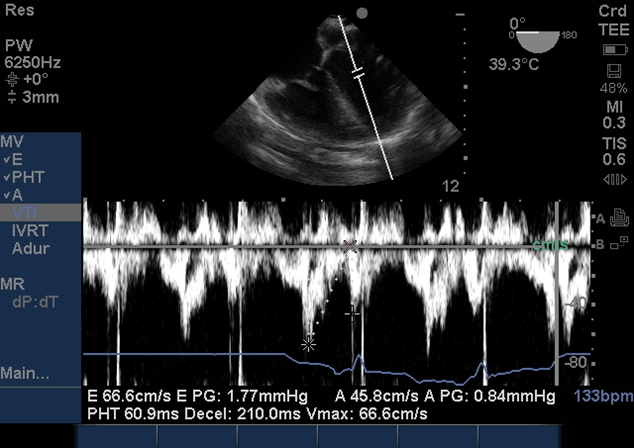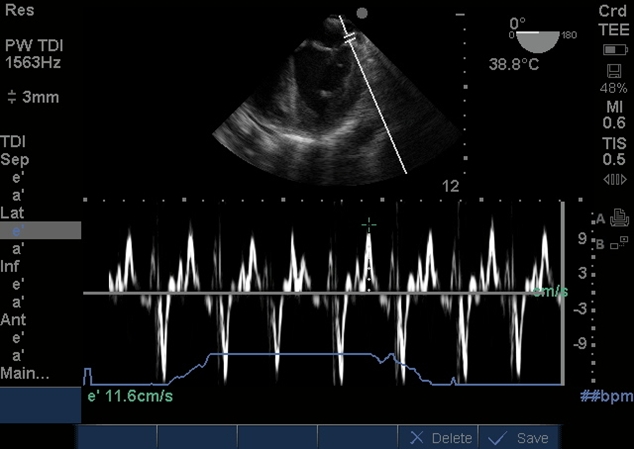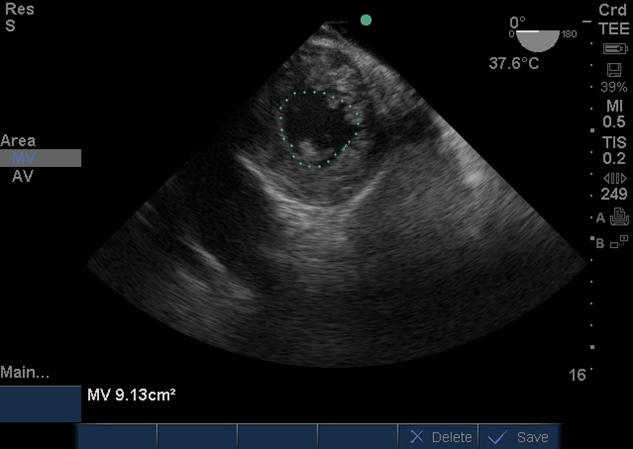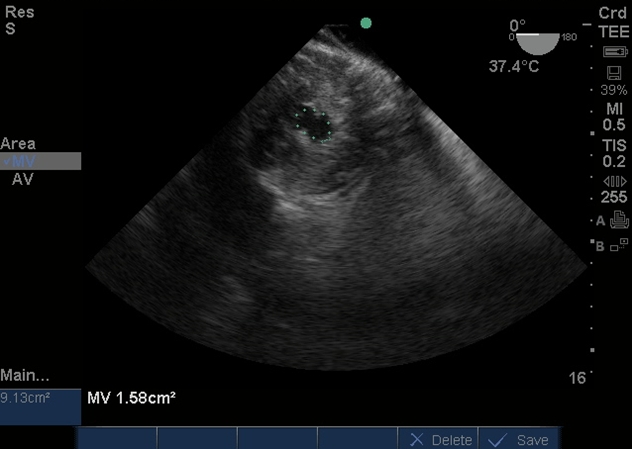Chapter 8 - Transesophageal Echocardiography: Image Acquisition and Transducer Manipulation
Case 8-1. Hypotension and Urosepsis
This transesophageal echocardiogram (TEE) was performed on a patient who presented with hypotension and urosepsis with poor-quality transthoracic echocardiography (TTE) views. In the short-axis view, the aortic valve (AV) has no anatomic abnormality and color Doppler interrogation reveals no regurgitation (Videos 8-1A and 8-1B). This is confirmed in the long-axis view of the AV (Video 8-1C). There is a left atrial mass, which was an unanticipated finding. A common indication for TEE is in the patient with hemodynamic failure where TTE views are of poor quality. The examination includes the assessment of valve function to look for a lesion that will complicate management or for the occasional unanticipated finding of catastrophic valve failure causing the shock state. In this case, the AV was normal. The unanticipated finding of a left atrial mass reminds the intensivist to remain alert for incidental findings that are separate from the primary structure of interest. The mass was a sarcoma.
Case 8-2. Hypotension
This transesophageal echocardiogram (TEE) was performed on a patient who presented with hypotension and poor-quality transthoracic echocardiography views. The patient was on ventilatory support and without any spontaneous breathing effort. The bicaval view shows a pacer wire in the superior vena cave (SVC) with adherent masses consistent with pacer wire thrombi (Video 8-2). At the end of the video clip there is possible reduction in SVC size. This could reflect preload sensitivity or respiratory translational artifact. An M-mode tracing of the SVC shows no respiratory variation indicating absence of preload sensitivity (Figure 8-3). The bicaval view of the SVC has major utility for determination of preload sensitivity. To make the measurement of respiratory variation, the patient must be passive in their interaction with the ventilator; but this is usually the case during performance of the TEE. The incidental finding of pacer wire thrombi complicates management of the case, as an argument can made in favor of anticoagulation. The unanticipated finding of the thrombi reminds the intensivist to remain alert for incidental findings that are separate from the primary structure of interest.
Case 8-3. Unexplained Hypotension
This transesophageal echocardiogram (TEE) was performed on a patient who presented with unexplained hypotension and poor-quality transthoracic echocardiography (TTE) views. The left ventricular function is normal, as is the size and function of the right ventricle (Video 8-3A). There is no pericardial effusion and the mitral valve anatomy is normal without major mitral regurgitation (Video 8-3B). A common indication for TEE is when TTE is not of adequate quality to answer the clinical question at hand. In this case, TEE results did not establish a cause for the shock state. Was the study of clinical utility; or was it, being normal, unnecessary? A normal result is a useful result, as it allows the intensivist to rapidly exclude a variety dangerous diagnoses. The TEE results suggest that the patient has distributive shock and that treatment with pressor agents is indicated without use of inotropic support. Determination of preload sensitivity will require other TEE views. The patient had septic shock as a final diagnosis.
Case 8-4. Fever, Elevated White Count, and Hypotension
This transesophageal echocardiogram (TEE) was performed on a patient who presented with fever, elevated white count, and hypotension with poor-quality transthoracic echocardiography views. The left ventricular function is normal, but the right ventricle (RV) is dilated (Video 8-4A). There is trace mitral regurgitation (Video 8-4B), and an indeterminate amount of tricuspid regurgitation, as a wall jet is present (Video 8-4C). This patient presented with septic shock. The TEE examination showed a dilated RV. This prompted the critical care team to search for additional diagnosis, and led to discovery of pulmonary emboli related to deep venous thrombosis diagnosed by the intensivist with a bedside study. The presence of RV dilation represents a specific contraindication to volume resuscitation unless there is other definitive indication of preload sensitivity. Early performance of TEE established a dual diagnosis for the shock state, and allowed the team to avoid inappropriate volume resuscitation.
Case 8-5. Hypotension and Severe LV Failure
This transesophageal echocardiogram (TEE) was performed on a patient who presented with hypotension, a history of severe left ventricular (LV) failure, and poor-quality transthoracic echocardiography (TTE) views. There is severe LV dysfunction with evidence of segmental wall abnormality (Video 8-5). The anterolateral wall is contracting to some extent, while the inferoseptum is akinetic. This was noted on other views. The segmental wall abnormality suggests an ischemic pattern, although it is not diagnostic. The image is somewhat off axis, and would be supplemented by several other images. A more complete hemodynamic assessment would require measurement of the LV stroke volume (SV) (see Cases 8-11 and 8-12), as LV dysfunction with severe reduction of ejection fraction may not necessarily be associated with a reduction of SV.
Case 8-6. Fever, Severe Dyspnea, Hypotension, and Bilateral Diffuse B Lines with Smooth Pleural Surface
This transesophageal echocardiogram (TEE) was performed on a patient who presented several days of fever, sudden onset of severe dyspnea, hypotension, bilateral diffuse B lines with smooth pleural surface, and inadequate transthoracic echocardiography (TTE) views. There is a mitral valve (MV) vegetation with a flail leaflet (Video 8-6A). The mitral regurgitation (MR) by color Doppler does not appear severe on this view, but the color Doppler jet suggests a wall jet pattern (Video 8-6B). Wall jets systematically underestimate the severity of MR. Other measurements such as vena contracta or regurgitant fraction and volume would need to be performed for quantitative measurement of the MR. The combination of acute respiratory failure, evidence of acute cardiogenic pulmonary edema on lung ultrasonography examination with hypotension prompted the critical care team to consider catastrophic valve failure. Prompt identification of the MV failure led to insertion of an aortic balloon pump and lifesaving surgical intervention. An early TEE examination was indicated in view of the nondiagnostic TTE examination.
Case 8-7. Hypotension and Ventilatory Support
This transesophageal echocardiogram (TEE) was performed on a patient who presented with hypotension, while on augmenting doses of dobutamine and diuretics and ventilatory support that included PEEP. Transthoracic echocardiography views were inadequate. There is systolic anterior motion of the anterior mitral leaflet (SAM) (Video 8-7A) and turbulent flow pattern in the left ventricular outflow track (LVOT) on color Doppler (Video 8-7B). Although not a common finding, SAM may have hemodynamic consequence if combined with inotropic support, diuresis, and mechanical ventilatory support that tends to reduce venous return and preload. As the LVOT obstriuction worsens due to the SAM, the MR may also worsen due to displacement of the anterior leaflet. TEE allowed identification of this pattern. The critical care team responded by giving volume and switching to phenylephrine with improvement of hemodynamics.
Case 8-8. Respiratory Failure, Bilateral B Lines, and Reduced LV Function
This transesophageal echocardiogram was performed on a patient with respiratory failure and bilateral B lines on lung ultrasonography with reduced left ventricular (LV) function. Figure 8-8A is of the mitral valve diastolic inflow and is a required measurement when using the standard algorithm for estimating left atrial pressures in the patient with reduced LV function (see Chapter 9). The E/A ratio is 1.5, so that the mitral valve annular velocity is required to give an estimate of LAP. Figure 8-8B is of the lateral mitral annular velocity measured with tissue Doppler imaging of the same patient. This is a required measurement when using the standard algorithm for estimating left atrial pressures in the patient with reduced LV function (see Chapter 9). The e' velocity is 11.6 cm/s. So the E/e' ratio is 5.8. The LAP is normal. The bilateral B lines are not caused by elevation of LAP, but rather by a primary lung process.

Figure 8-8A. Mitral valve diastolic inflow, a required measurement when using the standard algorithm for estimating left atrial pressures in the patient with reduced LV function.

Figure 8-8B. Lateral mitral annular velocity measured with tissue Doppler imaging of the same patient.
Case 8-9. Two Patients with Unexplained Hypotension
Video 8-9A was performed on a patient with unexplained hypotension and poor-quality transthoracic echocardiography (TTE) views. Overall left ventricular function (LV) and septal kinetics are normal. There is end systolic effacement of the left ventricle (LV). Video 8-9B was performed on a patient with unexplained hypotension and pulmonary artery hypertension with poor-quality transthoracic echocardiography (TTE) views while on ventilatory support that included PEEP of 15 cm H2O. There is septal flattening at the end of systole and during diastole. The transgastric short-axis view is often easy to obtain and gives a useful assessment of overall LV function, as well as septal kinetics. The patient in Video 8-9A had distributive shock due to sepsis with end systolic effacement of the LV cavity. The critical care team assessed preload sensitivity and gave volume resuscitation to the patient while treating the hypotension with phenylephrine. Regarding the patient in Video 8-9B, the late systolic flattening of the septum reflected the prolonged right ventricular (RV) ejection caused by the pulmonary hypertension (pressure overload of the RV), while the diastolic septal flattening was caused by severe tricuspid regurgitation (volume overload of the RV). The critical care team gave diuretics to the patient and took measures to reduce RV afterload by reducing PEEP with ventilator adjustment.
Case 8-10. Calculation of FAC in Patient with Unexplained Hypotension
This transesophageal echocardiogram was performed on a patient with unexplained hypotension. The images show the left ventricle using the transgastric short-axis view in systole and diastole. The endomyocardial borders are traced (not including the papillary muscles) to derive the fractional area change (FAC). The FAC% is calculated as (EDA -- ESA)/EDA, where EDA is end-diastolic area (Figure 8-10A) and ESA is end-systolic area (Figure 8-10B). In this case, this FAC is 83%. An FAC above 48% is normal. The FAC is an index of overall LV function that is straightforward to perform when compared to the complexity of the formal Simpson's measurement. The transgastric short-axis view is generally easy to obtain, and the planimetry can be done quickly. A problem with the measurement occurs if there is segmental wall abnormality as the FAC measurement reflects function only at the mid segmental level.

